People on Twitter have always asked me ‘Why am I not a beer blogger?’, given that I’ll often post images of beer on Twitter or Instagram Stories, or that I’ll be in a pub during a Twitter travel chat, or that I’ll often mention beer as being a common part of my travels and life. And while it is true that I like beer, and that I go to pubs a lot because I find it easier to write/blog in them (especially those without Wi-Fi) without being distracted by the Internet or domestic things, and it’s very hard to spend two hours in a pub drinking only hot chocolate, the truth is I could never be a proper beer blogger. I want to enjoy my beer, and use it as a method to blog, rather than having to worry about every sip, every taste, and make detailed notes on every beer I try. Beer is what I have when I do other things.
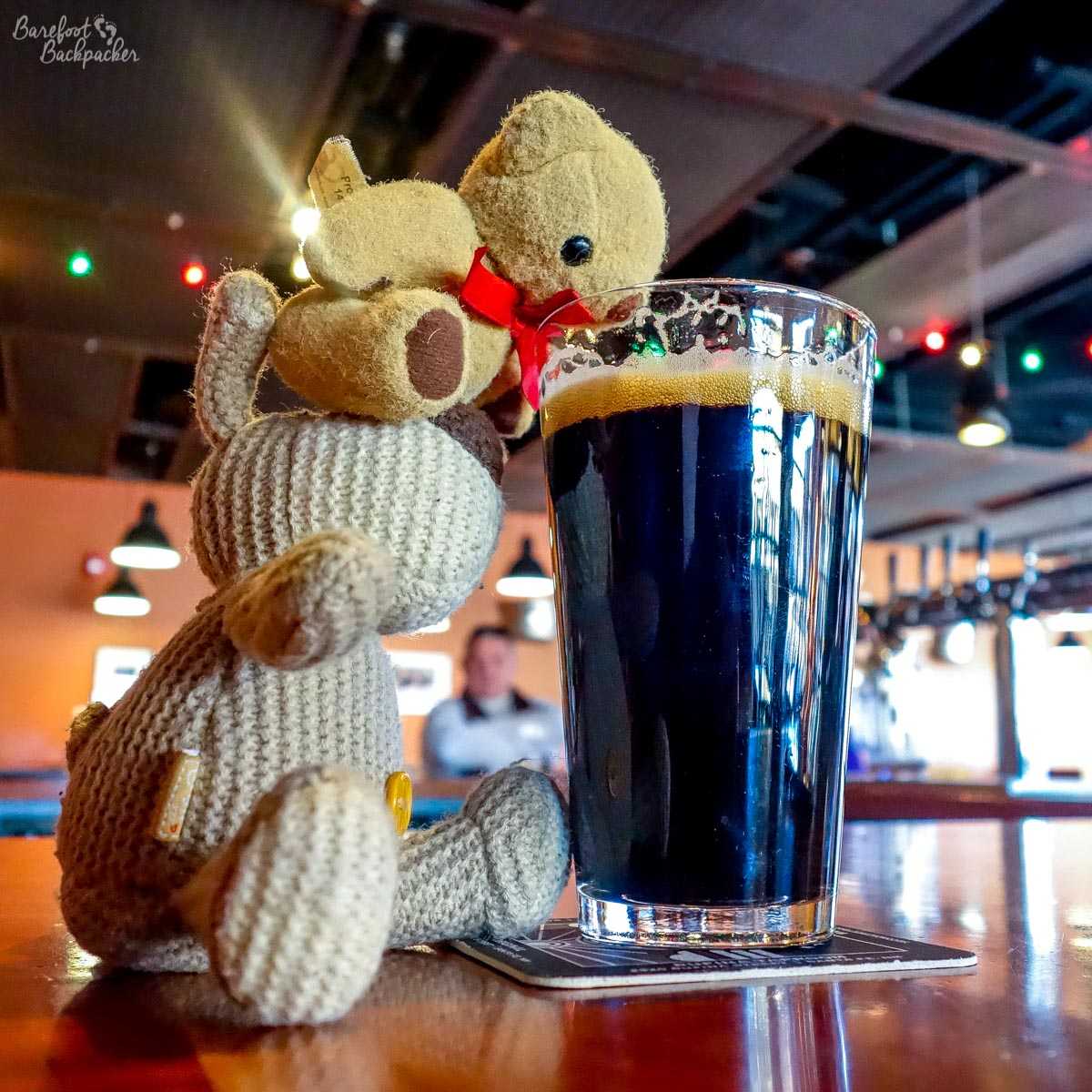
I’m evidently not the only one who likes beer! Baby Ian and Dave making fools of themselves at Second Street Brewery, Santa Fe NM.
That doesn’t mean, of course, I won’t talk and blog about it. And naturally I like to sample it whenever I’m on the move. In my experience the very best beer comes from Belgium, but perhaps surprisingly the country that runs it close, in terms of variety, style, taste, and ubiquitousness, is the USA.
Now, the USA has always had a bit of a bad reputation when it comes to beer. When many people here in the UK imagine American beer, what first comes to mind is the mass-produced tasteless lagers like Coors, Budweiser, and the like. And while they are everywhere (this is a country where money and advertising is King, after all), digging even only slightly deeper brings up a whole world of craft beer; something to everyone’s tastes.
Part of the reason for this reputation lies with the prohibition era of the 1920s and early 30s; while during it alcohol was technically banned, people came up with creative ways to both brew and sell it (hence all those stories about ‘bootlegging’ -> hiding often home-made moonshine or imported alcohol in the lining of the boot and selling it on in liquid drug deals). This was much easier to do with spirits than beer, so the beer market basically collapsed and only the really largest beer manufacturers survived (because with enough clout and money, law becomes a flexible beast). And I guess it never really recovered – while beer came back, these larger companies dominated and controlled the market, and even ended up swallowing each other, to the extent that in the late 1970s there were less than 100 breweries in the entire country.
While home-brewing was legalised in many states in 1978, it’s really only been in the last 10 years that the craft beer market has exploded, and although there are now just under 6½ thousand breweries in the country, still around 88% of the US beer market is controlled by three companies – Anheuser-Busch (Budweiser, Stella Artois, Becks), MillerCoors (Miller, Fosters, Coors), and Pabst (Pabst Blue Ribbon, Ballentines, Schlitz) – the latter is much more of a Domestic than an International firm, and they also dabble with craft brewing more than the other two (although Anheuser-Busch do ‘own’ a number of small breweries, including “Elysian” in Seattle and “Camden Town” in London).
But it’s the craft brews I’m more interested in. As, I’m sure, you are. This is a travel blog after all, not a Social History lecture.
I’ve taken two trips around different parts of the USA in the last 5 months, one down the West Coast with a spot of the South-West desert, and the other a trail down parts of the East Coast and back up the Centre. I’ve sampled local craft beer from a fair swathe of the country, and I’ve made some interesting observations.
The first is the sheer number of breweries and beers on offer. In the UK, a micropub may have between 3 and 5 beers on tap, and a small selection of bottles. A brewpub or decent real ale pub will maybe stretch into the teens – the brewery tap for Lincoln Green brewery in Hucknall (“The Station”) has possibly 15, and the Lincolnshire Poacher real ale pub in Nottingham city centre can have about the same, plus a handful of craft beers on keg. This is small fry compared with the USA. One craft beer place I visited in Albuquerque NM had 98, another in Austin TX had 105. A bar in Portland OR had a beer menu that stretched to four pages, the likes of which I’d not seen since I was in Belgium.

Part of the list of beers on offer at Matanza Beer Kitchen, Albuququerque NM. You can see it runs to several pages …
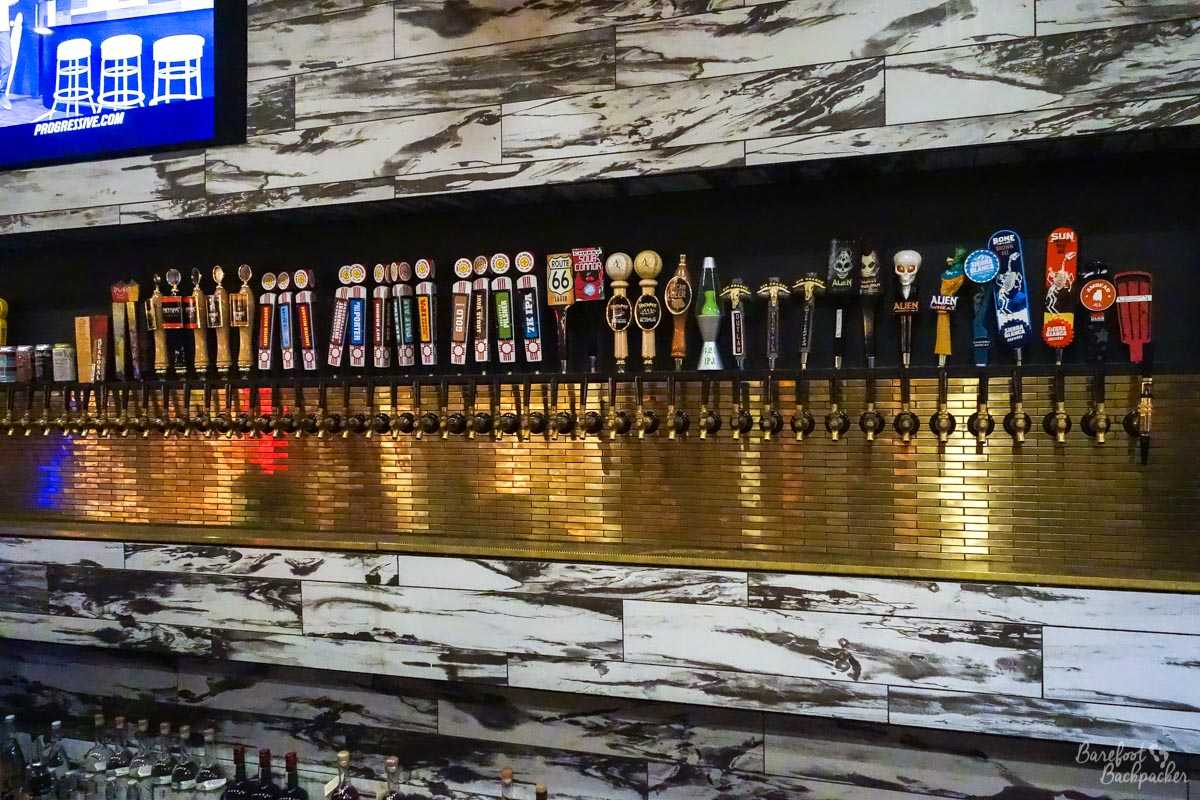
Selection of the beer taps at Matanza Beer Kitchen, Albuququerque NM. They are, mostly, local breweries – from this part of New Mexico.
Now, choice is all very well, but the next thing that becomes incredibly apparent is the average beer strength. There is a phrase that’s often cited, called “Session Ale”. This refers to a beer which, through a combination of alcoholic strength, an easy-drinking texture, and an uncomplicated taste, could be drank for a whole ‘session’ (the whole time you’re in the pub) without any major effects. I mean sure you’ll be over the limit to drive, but you won’t feel ‘drunk’ drunk, just pleasantly tipsy. In the UK, you’ll happily get beers self-defining as ‘session ales’ that are light, hoppy, and about 3.5 to 4.3% alcohol. On the beer list in one bar in Portland, “Session Ales” were given their own section. The lowest strength of them was 5.0%. In my experience, finding beers in the 6-8% range is not only not uncommon, but in fact pretty much standard – beer is made strong here, or at least stronger than Brits are maybe used to.
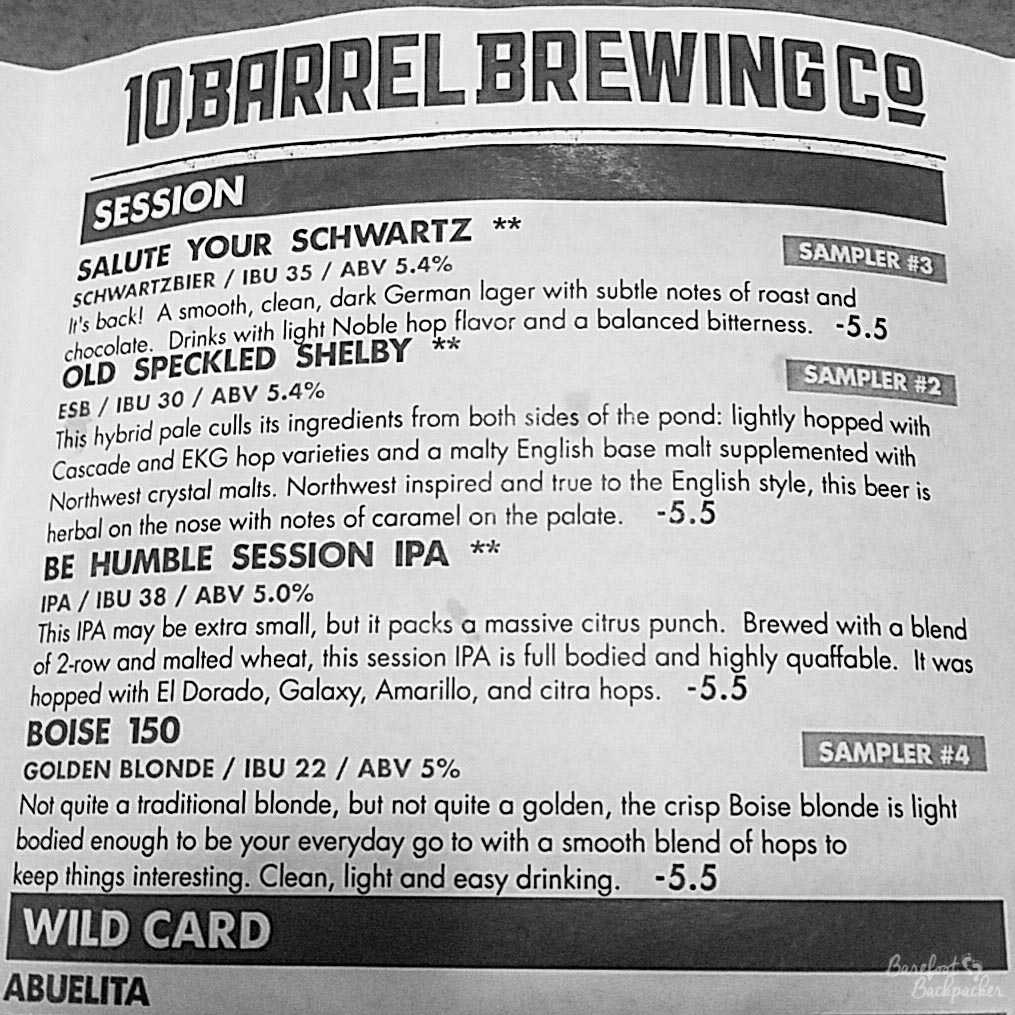
Part of the list of beers on offer at 10 Barrel Brewing, Portland OR. Note their interesting definition of ‘Session Ale’.
This is tempered somewhat by the wider variety of tastes and styles available (“Peanut Butter Porter” FTW!). American craft brewers don’t seem scared to experiment with all manner of flavours and concepts, unlike the British who seem to prefer to stick to simple variants on bitters, milds, porters, and IPAs. That’s not to say that American brewers don’t do simple beers, but of course this being the USA, they have to take things just that little bit further.
Take the IPA for instance; a strong hoppy beer originally designed in such a way to preserve beer for long journeys between the UK and India (hence its name ‘India Pale Ale’). These beers tend to be quite bitter; indeed there is a characteristic of beer called the IBU (International Bittering Unit) that measures just how bitter a beer is. Tellingly, industry professionals are the only people who seem to care about this figure in the UK – you never see it listed in pubs on menus or beer clips. However this figure is everywhere in the USA, openly listed alongside the alcoholic strength. Most beer will tend to range between about 10 and 50 on this scale, but some brewers in the USA have made it a task to make beers with as high an IBU figure as possible, occasionally breaching the magic ‘100’ mark, making the beer feel more like you’re drinking the entire brewery, worts (!) and all – decidedly unpleasant, to me anyway. Note you sometimes see high IBU figures on darker beers but that’s less noticeable as darker beers have more malt and flavour, so often need more hops to counterbalance it.
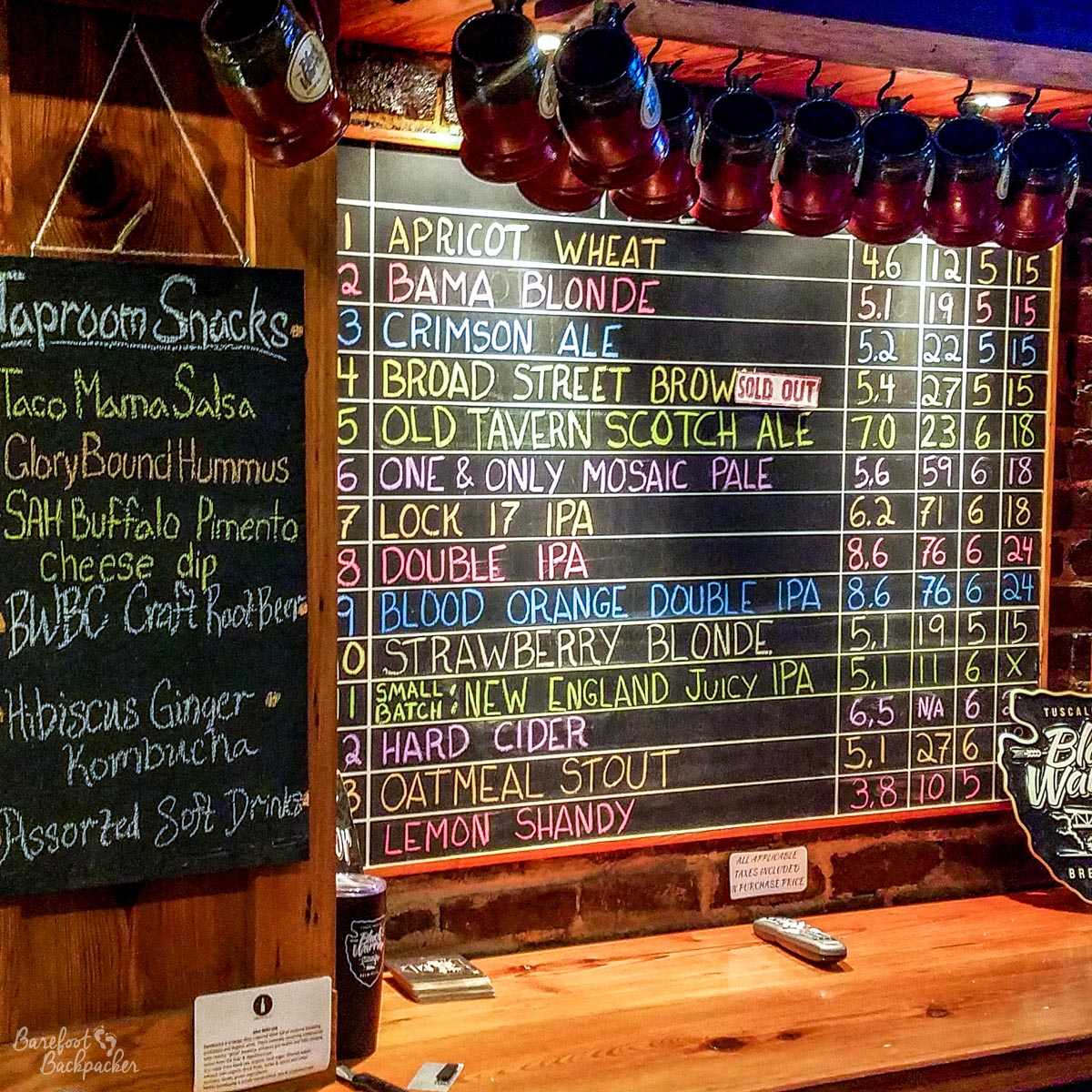
List of beers available at Black Warrior Brewery, Tuscaloosa AL. Note the IPAs with the very high IBU. As an aside, note the ‘shandy’ at nearly 4%!
Another thing I personally find unpleasant, although with a lot of beer your mileage definitely varies, and there’s certainly a market for it, is the proliferation of are often termed ‘sour’ beers. There was a phase of this in the UK a couple of years ago but I’ve not seen many recently; in the USA they’re everywhere. These are beers made with a modicum of ‘wild’ yeast (as opposed to the yeast being added in a controlled and measured way), and tend to have a very distinct acidic or ‘tart’ taste, akin to eating an acid drop / lemon drop type sweet. They’re a very distinctive and ‘acquired’ taste, and one I’ve never … acquired. Maybe I’m in the minority; they’re also very popular in Belgium (as ‘lambics’), but I’ve always preferred dark beers anyway …
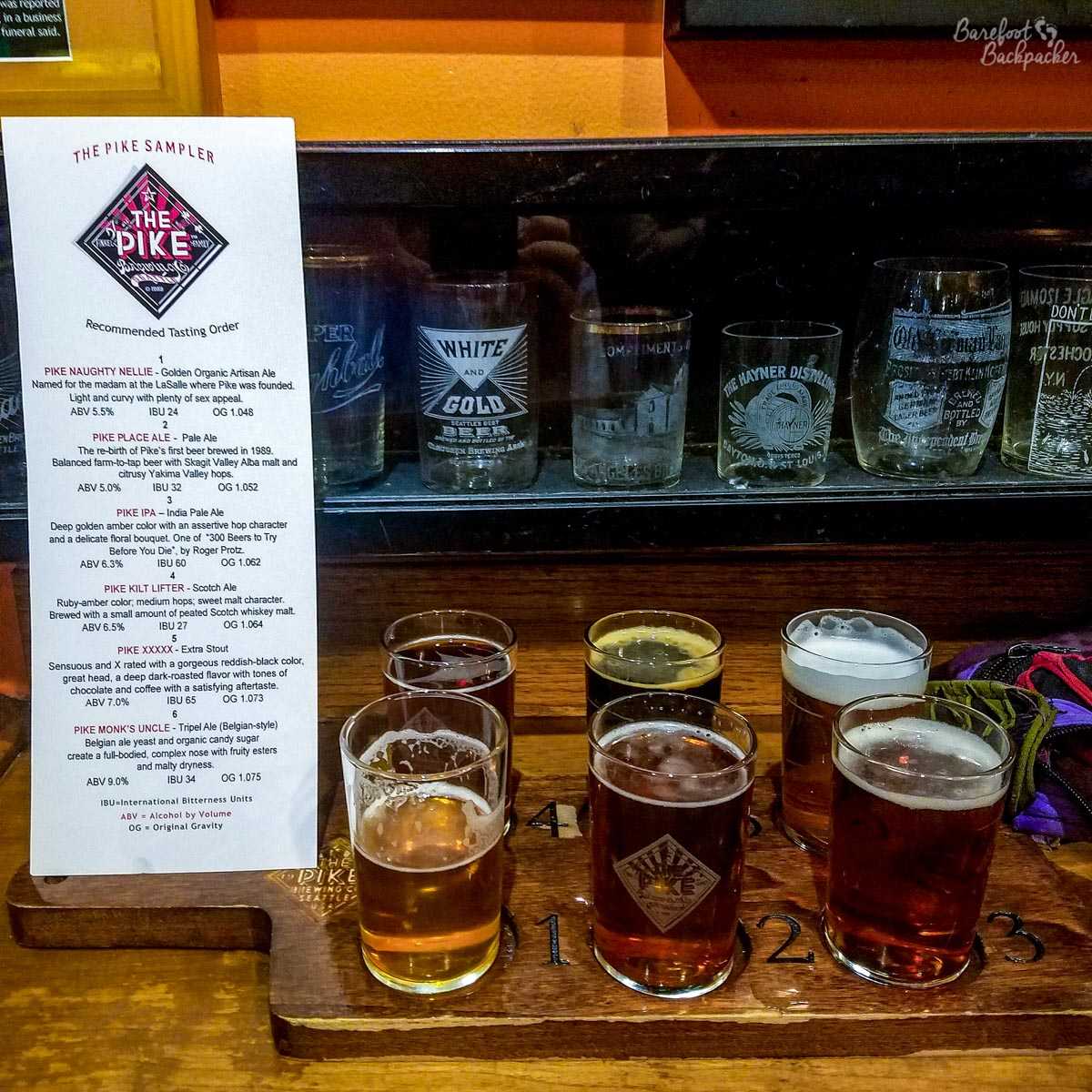
Flight of beers at Pike Place Brewery, Seattle WA.
With so much beer available though, you’re sure to find at least one you like in every pub, and pretty much every pub as at least one of each type of beer. ‘Flights’ are common, more so than in the UK, where you can have normally between 5 and 8 ‘samples’ (4 or 5oz, about 120 or 150ml) of any of the beers on tap, or you can just have a ‘pint’ (a US ‘pint’ is smaller than a UK pint; it’s 16oz / 473ml as opposed to 568ml / 19½oz. Though when the beer is as strong as it is, that’s no bad thing). Note also that the UK concept of half- and third- pints doesn’t often exist in the USA; it tends to be flights or pints.
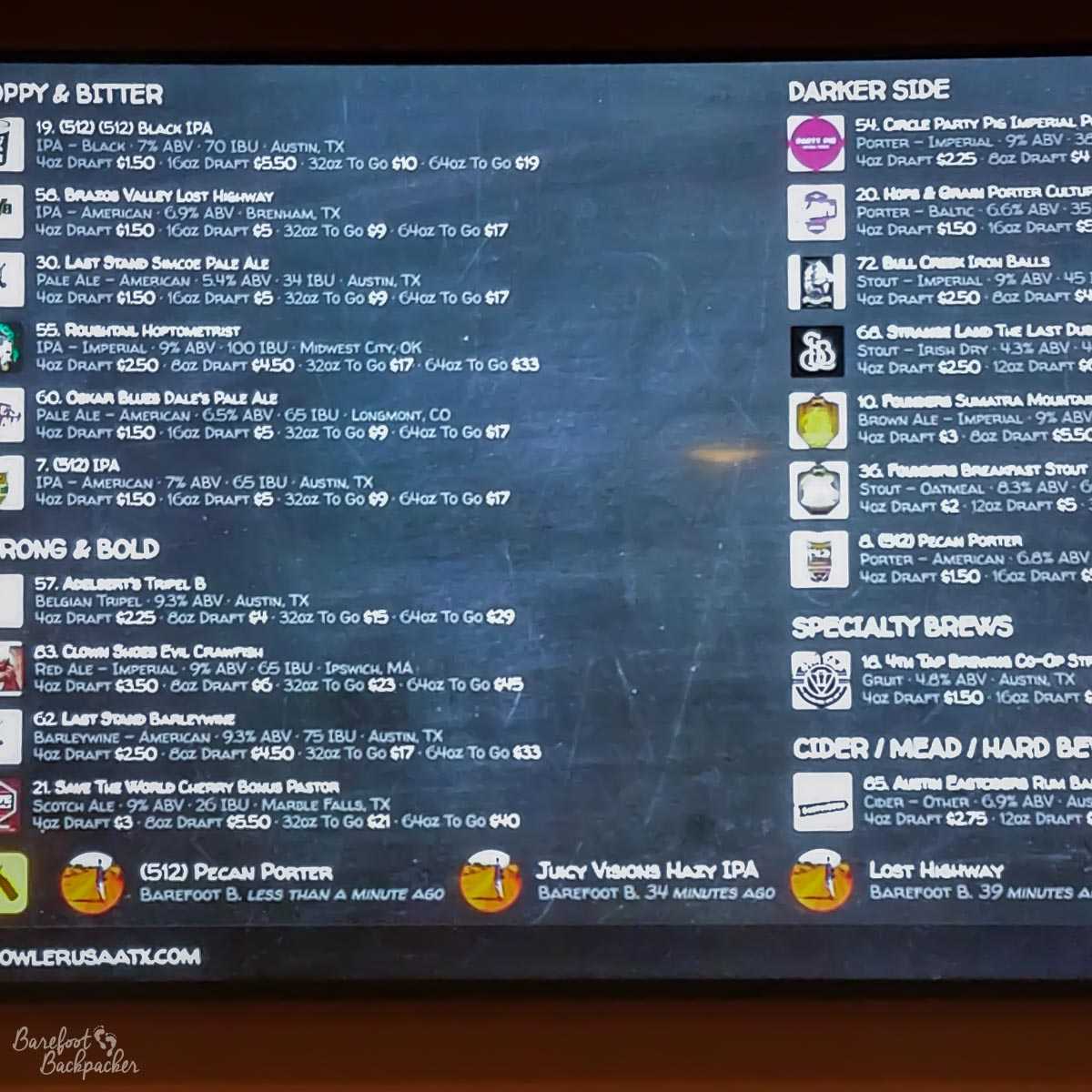
Part-list of beers at the ‘Growler USA’ in Austin TX. Note the strengths of the beer, and the sizes of them available. And yes, if you check-in there on Untappd, it displays it on a scrollbar at the bottom …
Even where it does exist, you often have an unusual pricing policy – one pub I went into in Albuquerque NM offered 12oz (355ml) for $5.50, 16oz (473ml) for $6.50, and 20oz (591ml) for £7.50 … I’d normally buy two or three of the half-pints in the UK (284ml / just under 10oz) but it’s just more cost effective to drink pints. Don’t worry though, many pubs have a ‘three pint limit’, which sounds harsh but you try drinking 3 pints of 9% double IPA and seeing how well you can walk afterwards. Depressingly, drink-driving is surprisingly common and there doesn’t feel as big a stigma about it as in the UK, although my friend in Dubuque IA suggested that’s because in a small town like that in the MidWest, there’s no public transport and no taxis, not even Uber, so if you want to go out for a drink, you either have to go in a group with a designated driver, or you just drink-drive. I guess there’s less traffic and the roads are straighter, but it’s still not useful.
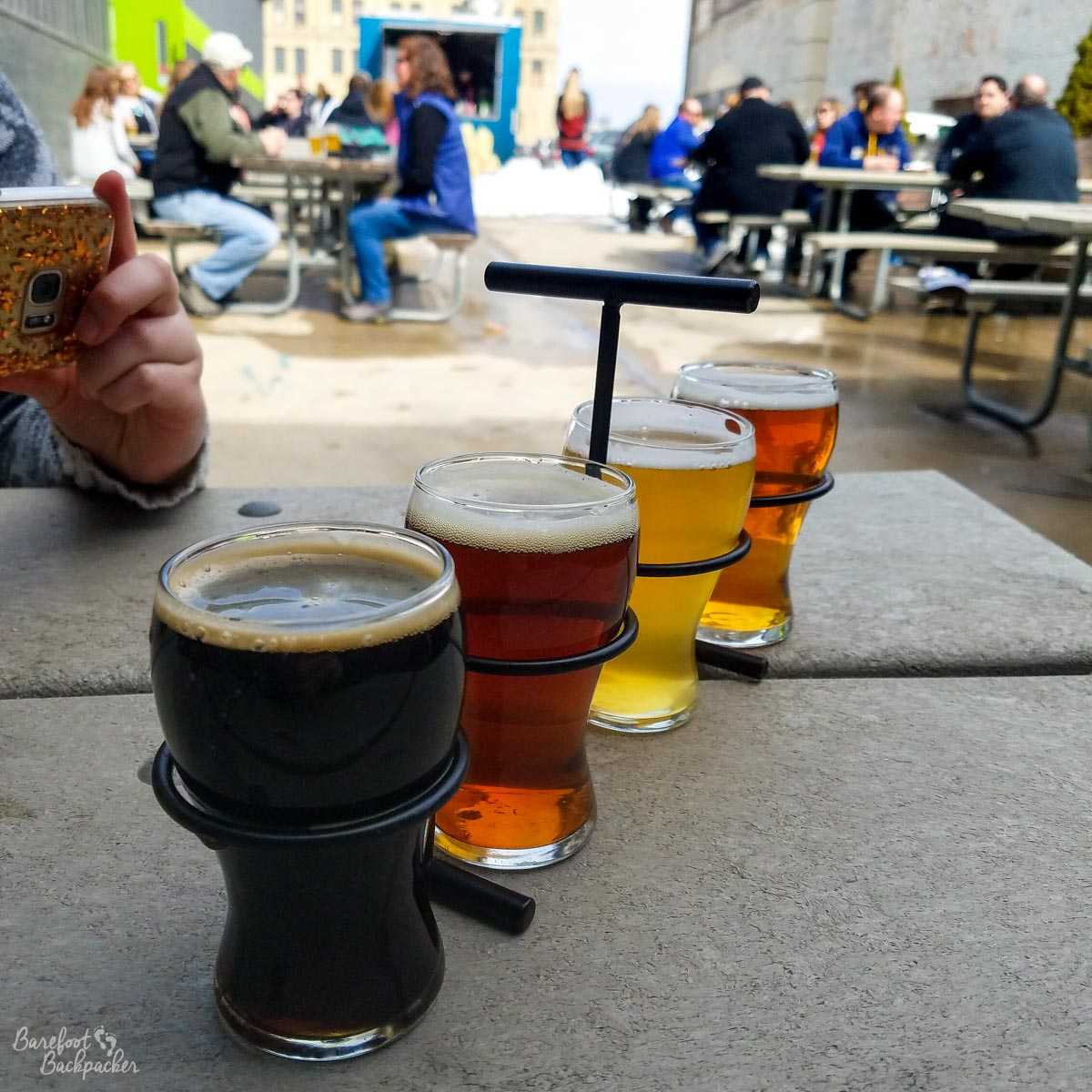
Row of flights at Third Space Brewing, Milwaukee WI. This place is, at least, near to the centre of town and on a couple of bus routes.
Of course I couldn’t spend my time just drinking beer while contemplating blog posts. My good Twitter friend Heidi Siefkas lives near Ft Lauderdale in Florida, and on my last whistle-stop trip to the USA I passed by her for a couple of days. Before my visit she managed to get hold of a couple of tickets for a brewery tour at The Funky Buddha, a local microbrewery to her – one of her blog niches is (like me I guess) to discover things about her local area, and this had been on her list for a while, so she invited me along.
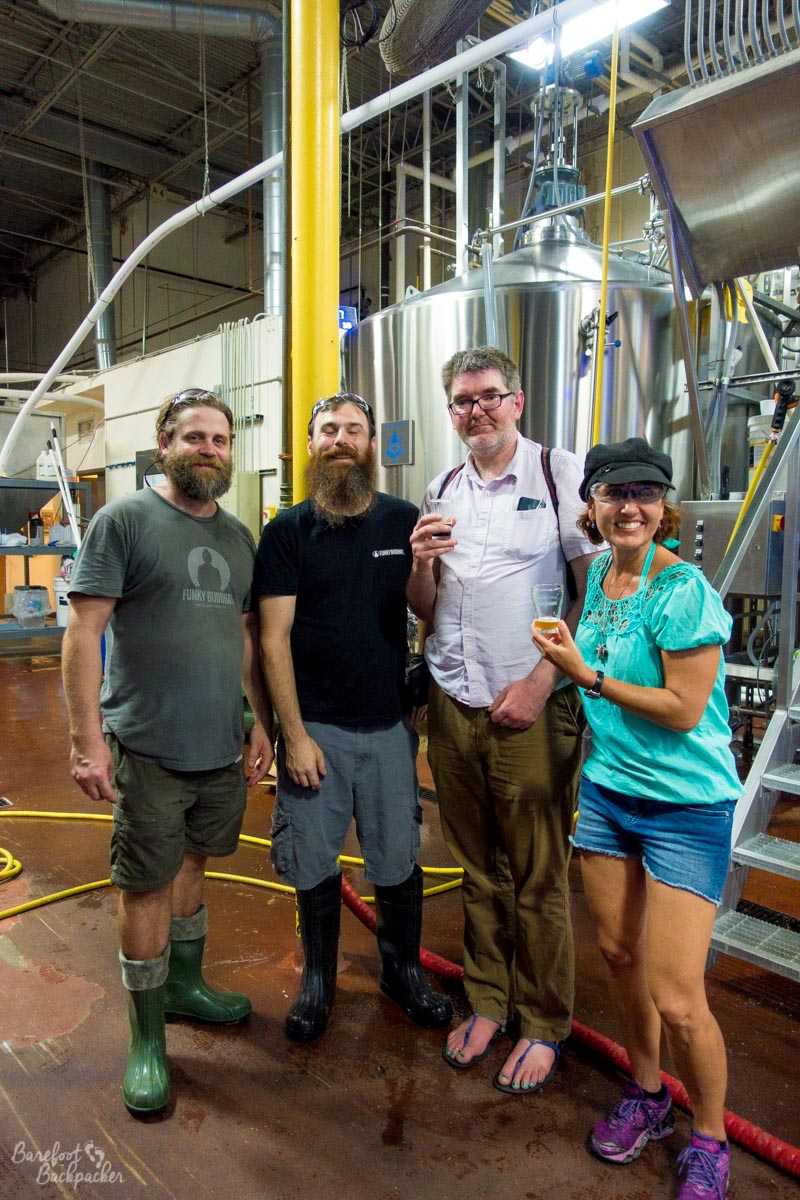
Two of the brewers at the Funky Buddha Brewery. Did someone say “stereotype”? :p
I’ve been to a couple of small breweries before, in the UK, so this was nothing new to me. It’s always interesting to see the beer production though; my uncle (and before him, his dad) made homebrew so I know the basic principles but it’s different seeing it at scale. It’s also intriguing to see the bottling process; as someone who drinks mainly draft beer in pubs, it’s not something I venture into much. Often the taste is different between bottled beer and the same beer on tap; for me, tapped beer tastes livelier and fresher, but I know that’s just personal taste.
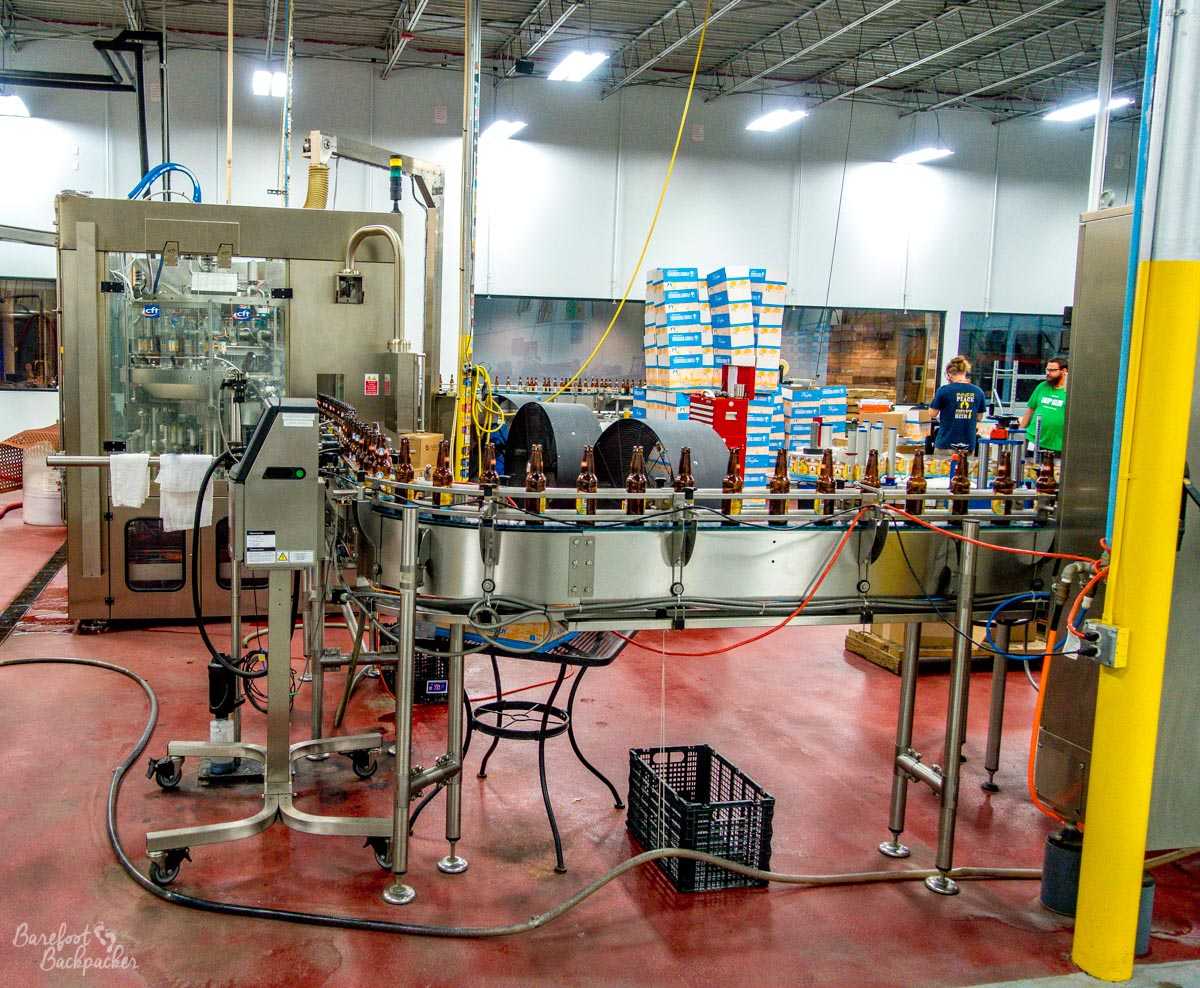
The bottling line at the Funky Buddha brewery; all nicely automated.
One thing that’s true the world over is often breweries have a light-hearted approach to beer names and idents (two breweries in the UK, Brewdog and Tiny Rebel, are particularly noted for this); Funky Buddha is no exception, with beers with names like ‘Hop Gun’ (oh dear) for an IPA, and ‘Wide Awake It’s Morning’ (a coffee porter with maple and bacon; breakfast in a bottle).
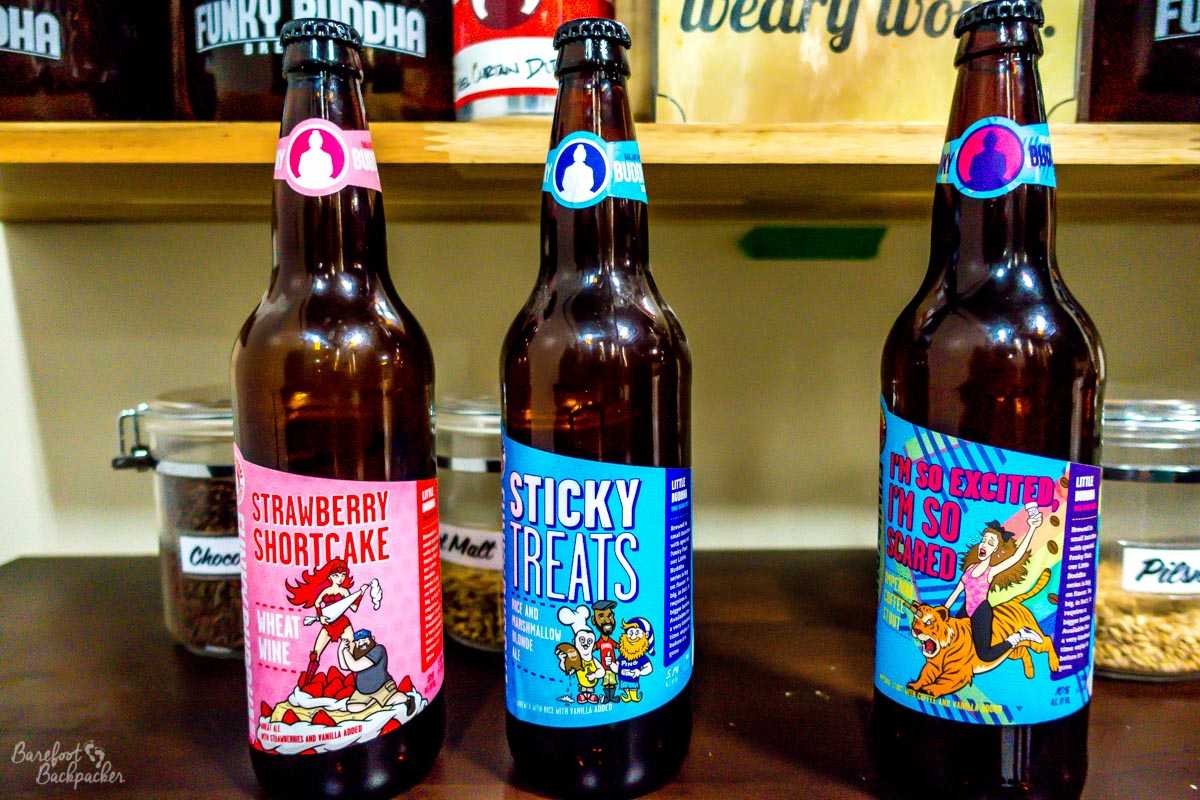
A couple of examples of beer labels & names at Funky Buddha. They have a ‘theme’ of quite racy imagery.
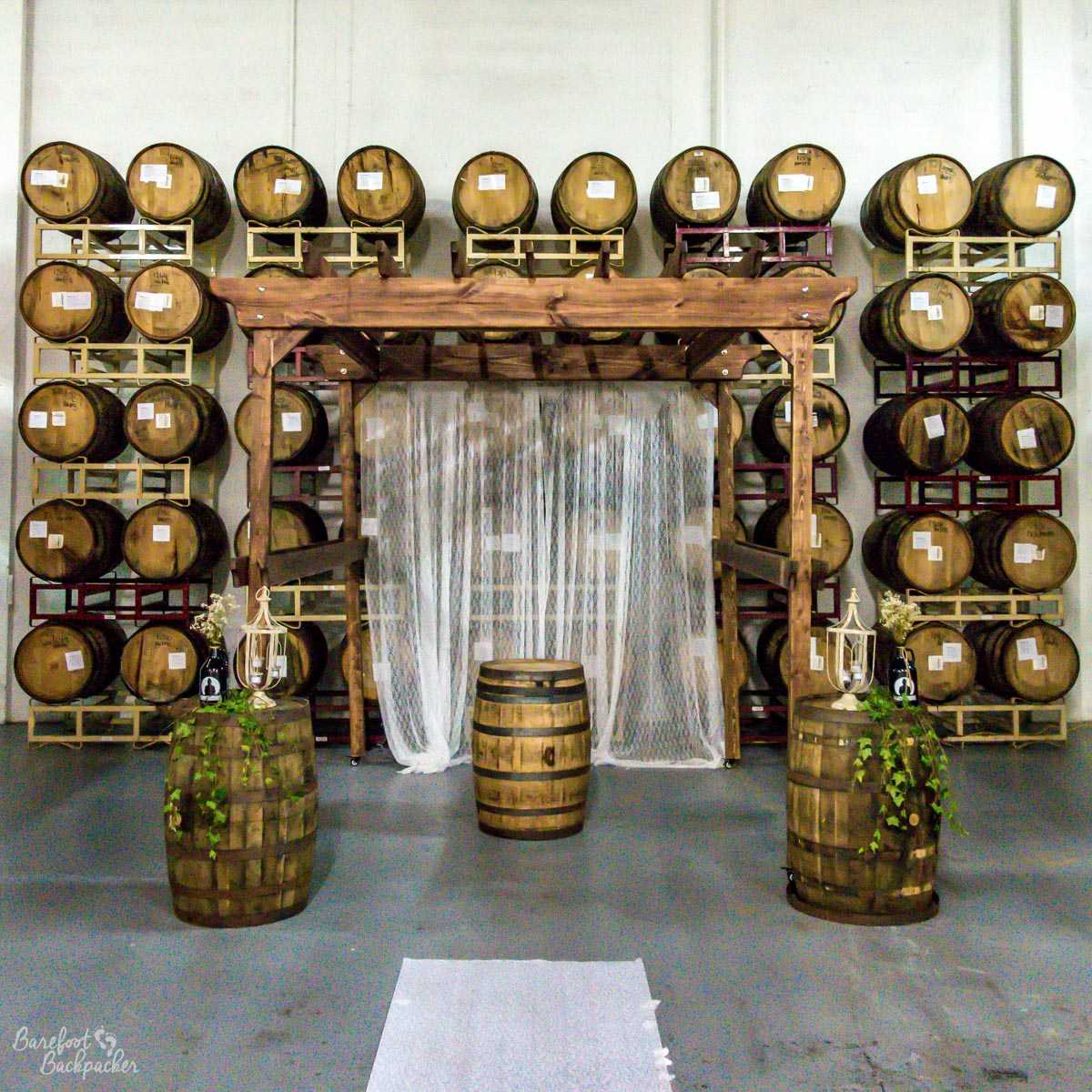
Some people like the beers so much at Funky Buddha, they choose to get married here!
My conclusions about beer in the USA are that there’s a lot of it, it’s strong, and if you skip past the big brewer’s lager, it’s mostly pretty darned good. Just steer clear of the sours …
—–
Like this post? Pin it!!
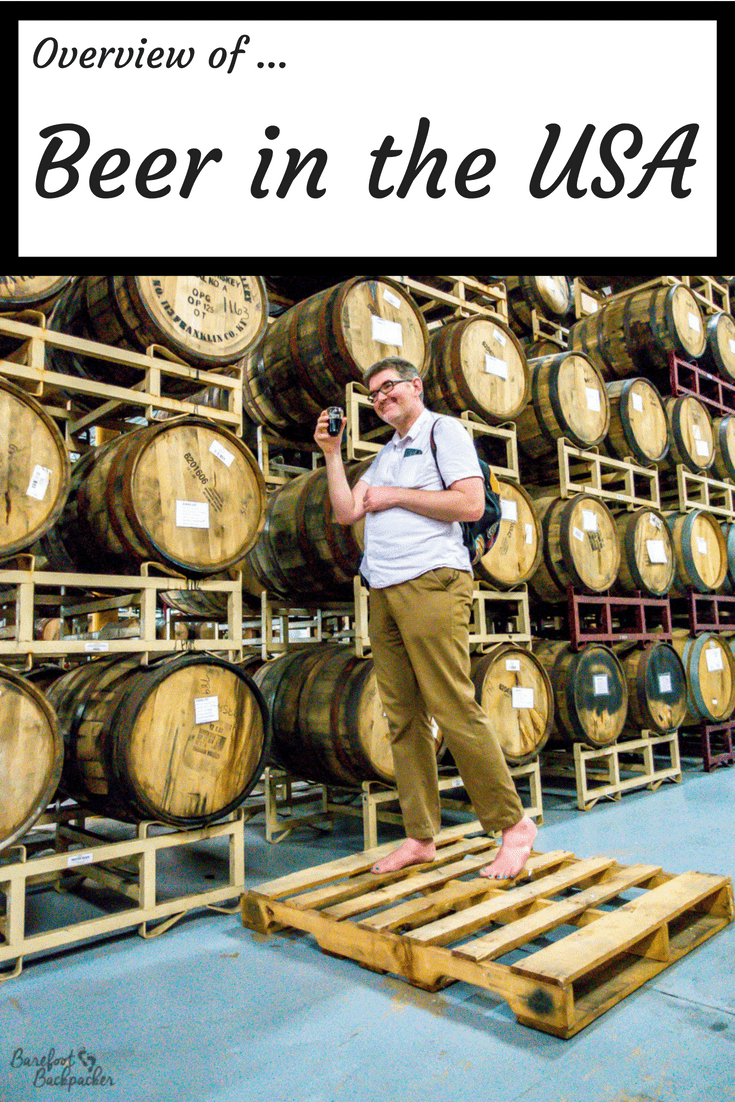
I’ve never heard of a wedding at a brewery but I kind of like the idea! Great article! Looks like a great time.
Haha, I mean, why not?! I always said if I got married, I’d have it in a field or hillside somewhere with a marquee tent filled with beers from local craft breweries!
Steer clear of the sours? No way! But to each their own.
I will say, the session beer ABV is something that the beer world here is just growing into and still being hotly contested. I would love to see it define beers as 4.5 or less, or at the very utmost 5% alcohol; however, with no restrictions, I think there are some places that just name things “session ale” to draw eyes to it.
In the backlash against the macrobreweries, American craft beer really started out gunning to be as high alcohol and high flavor as possible. Now we’re kind of settling back down and realizing that you don’t always need a 13% double IPA and a 4.5% pilsner is a damn fine beer.
Indeed; it’s a cultural thing maybe. To us in the UK a ‘session ale’ is, literally, ‘a beer you can have for a whole session of drinking’, which could be all afternoon. Try that with a 5% ABV and, yeh, it won’t happen lol! So many beers over here designed for long-term use are around 3.5% which makes them perfect for the all-day drinker!
And yes, 13% Double IPAs are pretty much undrinkable unless they’re your first and only beers of the day :p
Interesting stuff, thanks! I do like to drink a beer now and then but I don’t know a lot about microbreweries and the different ‘types’.
Nor did I until I did some research. And by ‘research’ I mean – read a book and, well, drank lots of different beer! 🙂
I’m with you on the sours and bitters. Fortunately a lot of the Virginia craft breweries create delicious dark beer. If you ever visit the DC area Charles McCool and I will take you to a few of our faves.
Oooh now there’s an offer I can’t refuse, thank you 🙂
Such an interesting post, although I’m not much of a beer drinker. I would really love to try out some of those flavours though! Peanut butter? Yes please. Also, I now know where the word ‘bootlegging’ comes from ( you learn something new every day). Great pictures too.
Thank you 🙂 Yes, that’s the beauty of American breweries; they’re not afraid to experiment with flavours – and with so much choice in the craft beer pubs, you’re sure to find something you like.
Really interesting blog post on microbreweries.
Thank you 🙂